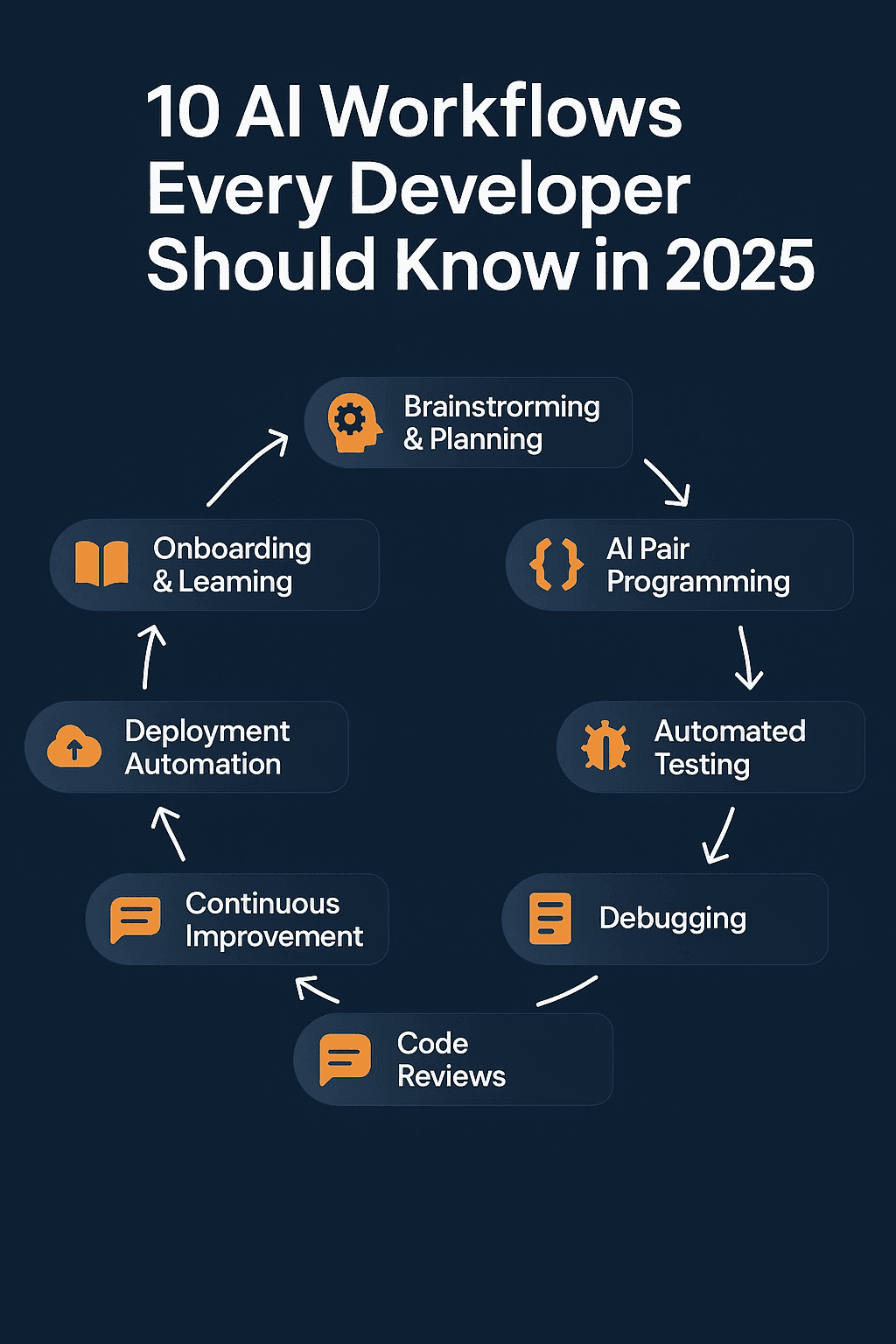10 AI Workflows Every Developer Should Know in 2025
10 AI Workflows Every Developer Should Know in 2025

10 Workflows which AI can help you with
Artificial Intelligence in 2025 is no longer a curiosity.
It’s not just “autocomplete for code.” It’s a set of workflows that can accelerate every phase of software development, from brainstorming to deployment.
In the past two years, we’ve seen developers who embrace AI work at 3–10× speed without sacrificing quality. I’ve personally built products in days that would have taken weeks — but only once I discovered how to use AI correctly.
This article is a deep dive into the 10 most powerful AI workflows every developer should know in 2025.
Each workflow is explained with:
Why it matters
Which tools to use (ChatGPT, Claude, Cursor, v0, GitHub Copilot, etc.)
How to apply it step by step
Real-world pitfalls to avoid
Let’s dive in.
1. AI-Assisted Brainstorming & Architecture Planning
Before writing a single line of code, the right AI workflow can save you days of trial and error.
Instead of saying “build this app,” you ask AI to act as a senior architect:
Suggest multiple approaches.
Ask clarifying questions.
Document assumptions in plain language.
Tools: Claude Code, ChatGPT
Why it works: You get a clear mental model before implementation.
Workflow:
Ask AI for multiple architectural patterns.
Challenge it with edge cases.
Generate a `ARCHITECTURE.md` file with diagrams and folder structure.
Pro tip: Don’t accept the first answer. Push the AI to explain why one design might fail.
2. UI Bootstrapping with AI Generators
Day one of a new project used to mean hours setting up UI boilerplate.
Now, tools like v0, Bolt.new, and AI-driven Figma-to-code can get you a working UI in minutes.
Workflow:
Describe your app in natural language.
Export the AI-generated skeleton.
Stop there — don’t try to extend the UI in the AI tool. Move into your IDE.
Pitfall to avoid: Spending hours “arguing” with the AI about library choices. Accept the bootstrap, then switch to manual coding.
3. AI Pair Programming in the IDE
The most transformative workflow is having AI inside your editor.
Cursor, GitHub Copilot, and JetBrains AI Assistant let you:
Generate code inline.
Refactor entire files.
Save “never do this again” rules.
Example:
Cursor remembers that your React components should always use PascalCase and never inline CSS. Every future suggestion follows that rule.
Result: Less babysitting, more flow state.
4. AI Test Generation & Automated QA
Developers hate writing tests. AI loves it.
Give AI a spec or a piece of code, and it can:
Generate unit tests.
Suggest integration test cases.
Even run them automatically and fix bugs.
Workflow:
Ask AI: “Write Jest tests for this function, including edge cases.”
Run tests.
Feed failed tests back to AI to fix.
Warning: AI-generated tests often cover the “happy path” only. Always review for missing edge cases.
5. Debugging with AI
Every developer has hit the wall of a bug that makes no sense.
AI turns debugging from hours into minutes:
Paste stack trace → AI explains cause.
Show broken code → AI suggests 3 fixes.
Integrate solution automatically.
Pro tip: If AI fails twice, stop. Search the error manually, then re-integrate via AI. Don’t fall into the “infinite retry loop.”
6. AI for Documentation & Knowledge Sharing
AI isn’t just for code.
It can generate and maintain living documentation:
API references
Coding guidelines
`README.md` files
Changelogs
Workflow:
After feature delivery, prompt AI: “Summarize this PR in plain English for future devs.”
Commit summary into docs.
This workflow ensures future devs (and your future self) don’t waste hours reverse-engineering.
7. AI-Powered Code Reviews
In 2025, AI reviews every pull request before a human sees it.
Why: Humans miss patterns. AI flags:
Inconsistent styles
Security vulnerabilities
Inefficient queries
Workflow:
Connect AI reviewer (like CodeRabbit, Codium, or Cursor PR review).
Configure it with your coding rules.
Let humans focus on architecture, not semicolons.
8. AI Deployment & DevOps Automation
Deployments used to be stressful.
Now, AI can:
Generate CI/CD pipelines (GitHub Actions, GitLab CI, CircleCI).
Suggest scaling configs for AWS, Vercel, or Kubernetes.
Automate rollbacks when errors spike.
Workflow Example:
Ask AI: “Write a GitHub Action that runs tests, lints code, and deploys to staging on push.”
— 2 minutes later, you have a working pipeline.
Future trend: Self-healing infra, where AI reconfigures servers automatically.
9. AI for Learning & Onboarding
New dev joins the team?
AI can summarize the codebase, answer “where is X implemented?” and even create learning paths.
Workflow:
AI-generated `ONBOARDING.md`.
Ask: “Explain the authentication system in 500 words.”
Provide guided questions so juniors can learn faster.
Impact: Cuts onboarding time from weeks to days.
10. AI for Continuous Improvement
The final workflow is meta: using AI to improve itself.
Gather pain points from your team.
Ask AI: “Where are we losing time in our dev cycle?”
Implement new workflows.
In other words, make AI part of your retrospective process.
The developers who keep refining AI usage will always outpace those stuck in old patterns.
Case Study: A Feature in a Day
Recently, I built a dashboard widget for a client in under 24 hours:
UI Foundation – Generated with v0 in 10 minutes.
Architecture Plan – Claude suggested 3 approaches, I picked one.
Implementation – Cursor wrote 80% of the code, I handled edge cases.
Bug Fixes – One bug was solved by AI, another with Stack Overflow.
Total time: ~7 hours. Traditionally: 2–3 days.
The client thought I’d worked on it for a week.
Final Thoughts
AI in 2025 isn’t optional.
It’s the new literacy of software development.
The developers who master these 10 workflows:
Brainstorming & planning
UI bootstrapping
AI pair programming
Automated testing
Debugging
Documentation
Code reviews
Deployment automation
Onboarding & learning
Continuous improvement
…will outpace their peers not by 10%, but by 10×.
AI won’t replace developers, but it will replace developers who don’t use AI.
👉 Which of these workflows will you start with tomorrow?